|
|
| My Favourite Planet > English > Middle East > Turkey > Ephesus > photo gallery |
| Ephesus, Turkey |
Ephesus photo gallery 1 |
 |
 |
5 of 62 |
 |
 |
|
| |
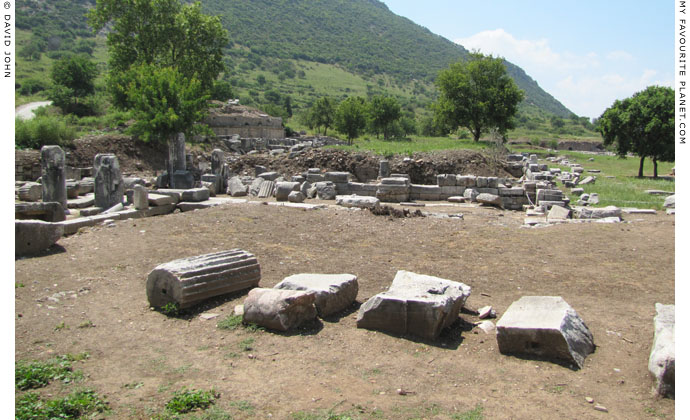
The south side of the Upper Agora. |
| |
The Upper "State" Agora
Part 2: the south side of the agora
The south side of the Upper Agora lacks the visually interesting monuments of the north side and therefore attracts few visitors. As everywhere else around the archaeological site there are parts of monuments which are not explained by guidebooks or information boards, such as the foundations of the building in the photo above.
A 10 minute walk along the road to the south of the agora takes you past a Hellenistic gateway, an enormous Roman water tank and the Hydrekdocheion (Water Palace), to the site's Inscriptions Museum (see next page) at the site of the Temple of Domitian (see page 13). |
| |
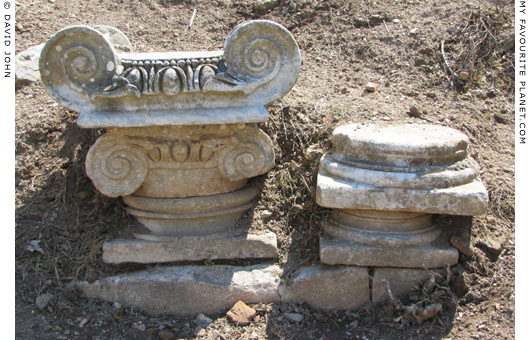
Ionic capitals and bases of columns stacked decoratively on
the side of the road along the south side of the Upper Agora. |
|
| |
| |
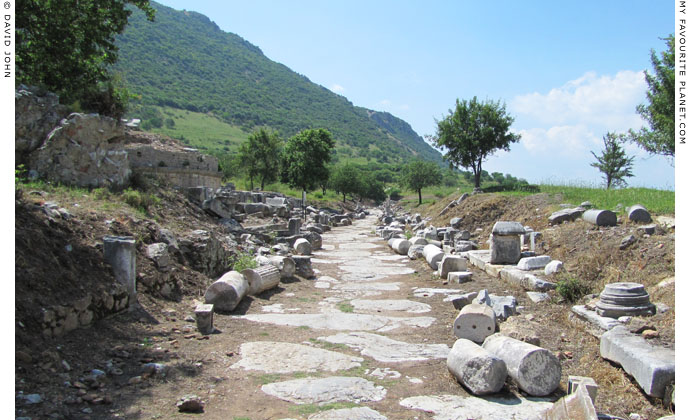
The road from the Magnesian Gate running west-east
outside the south side of the Upper Agora (right).
|
The road, which is aligned with the southern boundary of the agora (or was the agora boundary aligned with the road?), has its western end on the southwest corner of the agora, near the front of the Temple of Domitian, where it makes a 90 degree turn right, down to Domitian Square (see below). It is paved with huge stone slabs and littered with parts of columns and other pieces of monumental buildings.
To the left are the remains of a nymphaeum (monumental fountain) which fronted a water storage tank (see photo below). |
|
|
| |
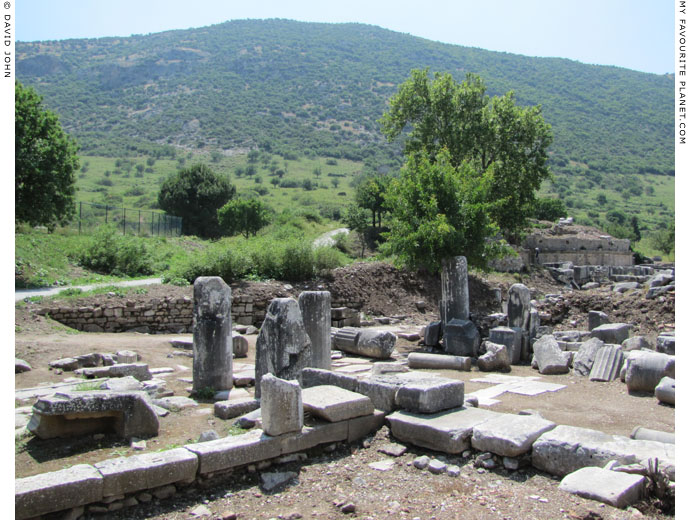
Remains of a monumental Hellenistic entrance gate to the south side of
the Upper Agora (right) from the Magnesian Gate road. Dated to the 2nd or
1st century BC, the gate had four prostyle marble Doric columns and two pillars. |
| |
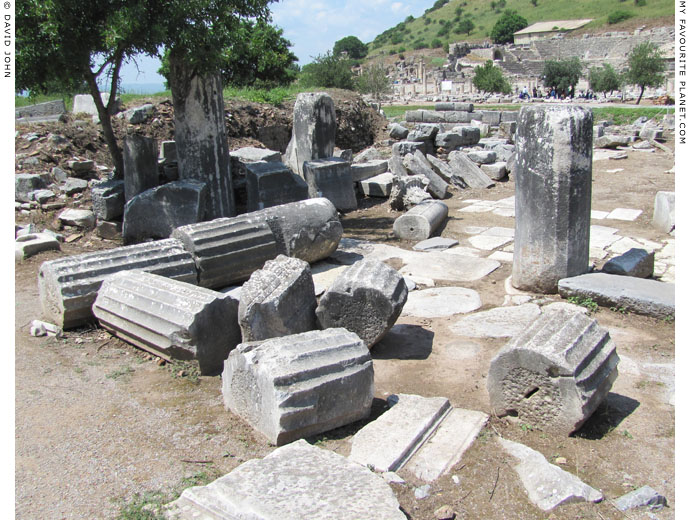
The Hellenistic gate viewed from the outside (south) on Magnesian Gate road. |
| |
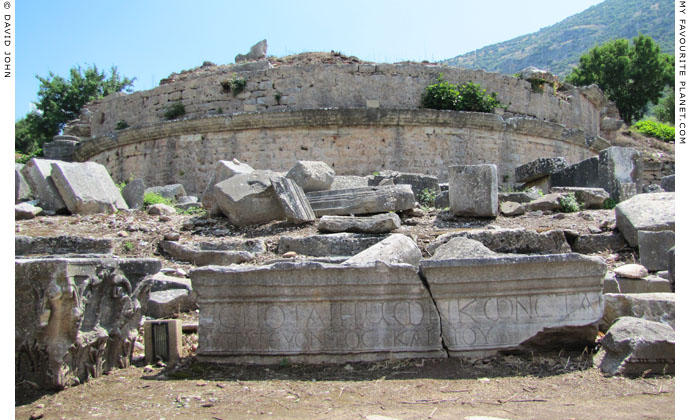
The remains of the "Fountain" and water tank on the road to the Magnesian Gate.
|
The building with a semi-circular plan was a large tank for storing and distributing water brought to the city by the Marnas Aqueduct, and is referred to as a nymphaeum (monumental fountain) on an inscription from the proconsulship of P. Calvisius Ruso Julius Frontinus, 92-93 AD.
It was enlarged in the 2nd century AD, with the addition of two side wings and a fountain basin at the front. Following severe damage, it was renovated around 340 AD by Proconsul L. Caelius Montius. It was decorated with statues, fragments of which were discovered during the excavation of the monument by the Austrian Archaeological Institue (ÖAI) in 1908. |
|
|
| |
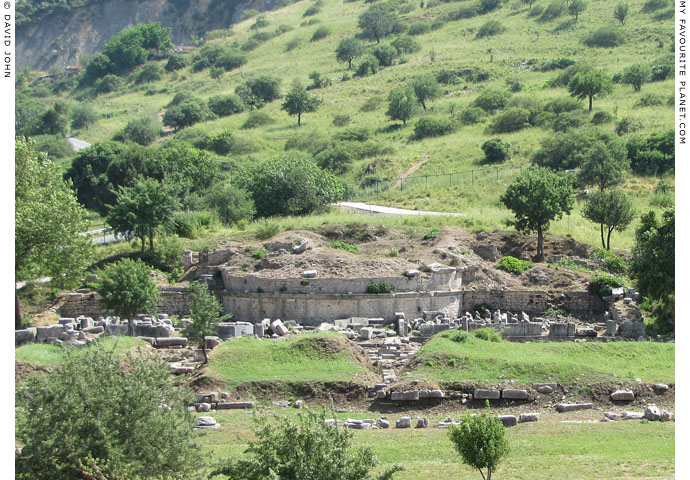
The "Fountain" with the later side wings, from the top
of the Bouleuterion on the other side of the Upper Agora. |
| |
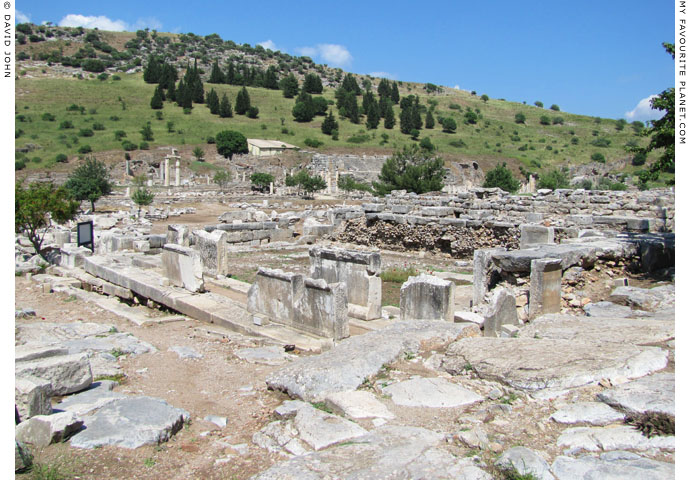
The Hydrekdocheion ("Water Palace"), also known as the "Fountain of Gaius Laecanius Bassus",
at the southwest corner of the Upper Agora. The monumental three-storey fountain, with an
aedicular facade decorated with statues (see the Library of Celsus), was donated by Proconsul
Gaius Laecanius Bassus around 80 AD. Note also the enormous stone paving slabs of the road. |
| |
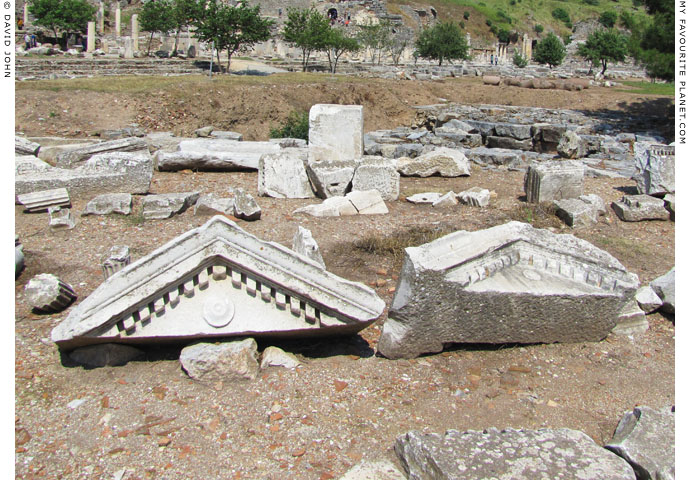
Two of the three small marble pediments from the aediculae the Hydrekdocheion,
displayed among several architectural fragments between the back of the building
and the agora temple (see previous page) on the west side of the Upper Agora. |
| |
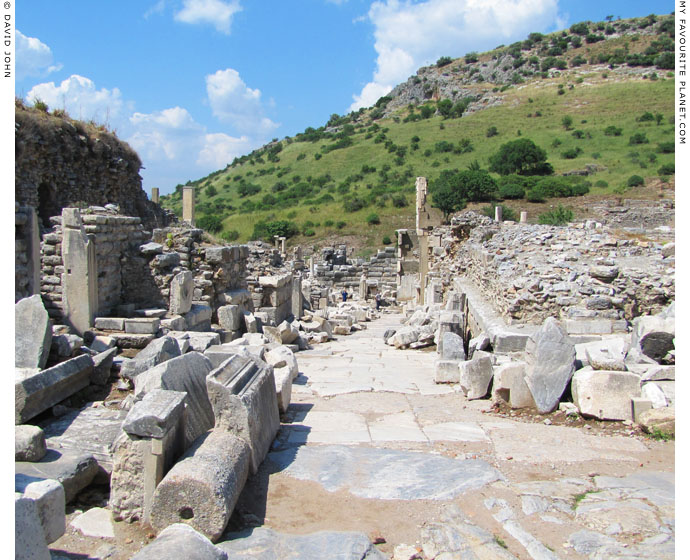
The southwest corner of the Upper Agora, Ephesus.
|
The road (foreground, right) from the Magnesian Gate ends below the Temple of Domitian. The high stone platform on which the sanctuary stood are on the left (west). See photo below.
At this corner the street turns 90 degrees right (north) and runs down to Domitian Square, the junction with the "Clivus Sacer" (Sacred Way) to the east, and Kuretes Street to the northwest and the centre of the city.
To the right (east) are the foundations of the west side of the Upper Agora, raised to keep the square level on the slope. |
|
|
| |
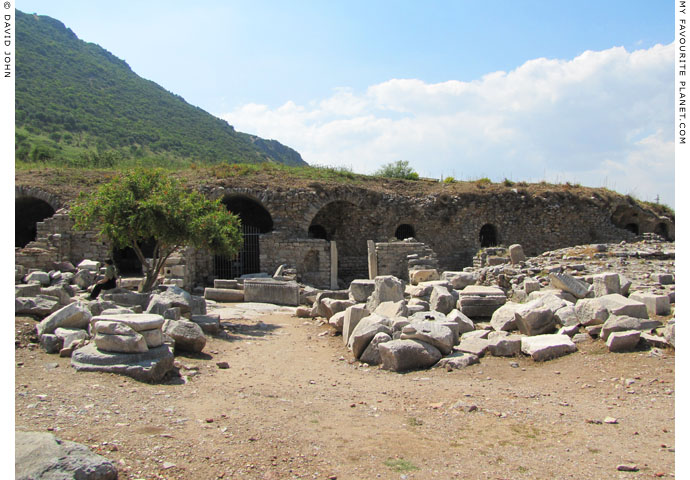
The vaulted substructure of the Temple of Domitian (see gallery page 13)
in which the Inscriptions Museum is now housed. |
| |
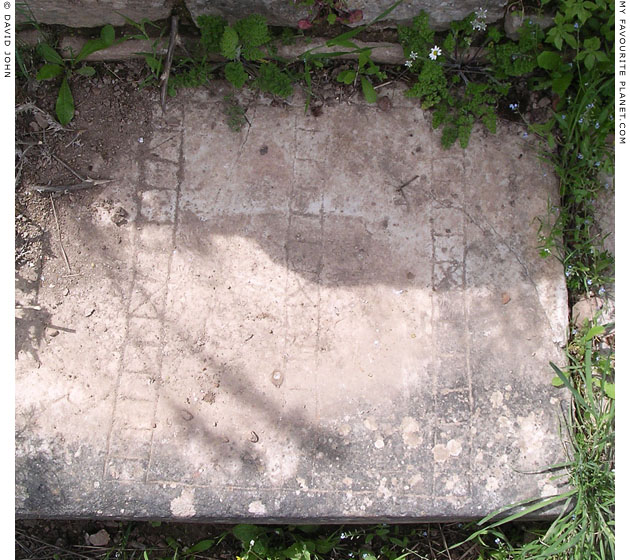
Ancient stone slab used as a gameboard. So what's the name of the game?
|
Several stone slabs roughly carved with various geometric patterns have been found in and around Ephesus and at many other archaeological sites of the Graeco-Roman world. They are thought to be ancient gameboards, although not much is known about when they were made.
This "gameboard" may have been scratched on the stone for an ancient version of backgammon, known in Greek as tavli (Tάβλη) and in latin as tabula, meaning table or board. The game was known in Roman times as Ludus duodecim scriptorum or XII scripta.
For further information about these graffiti "gameboards", see Selçuk gallery 1, page 11.
See a photo of another graffiti "gameboard" on Kuretes Street on Ephesus gallery page 17. |
|
|
| |
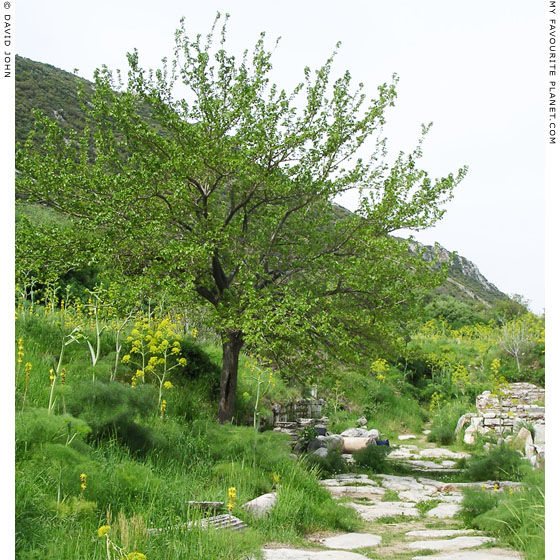
A tree on the road from the Magnesian Gate, at the foot
of Mount Koressos (Bülbüldağ, Nightingale Mountain). |
| |
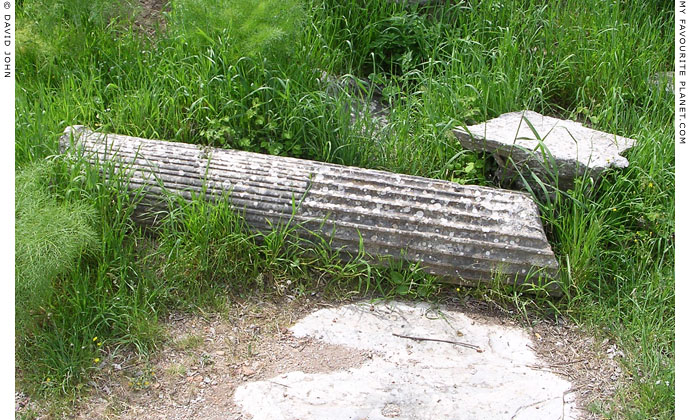
Fallen column beneath the tree above.
|
Many archaeological sites are littered with such columns, marble blocks and other ancient bits and pieces which appear to have been overlooked or forgotten by archaeologists and site managers.
Often though it is a matter of waiting for the time, budget and personnel to explore a particular part of a site thoroughly, identify and conserve the pieces and decide whether they can be (or should be) put together as a reconstruction of a monument or placed in a museum or storage.
Each time I visit Ephesus (my first visit was in 1985) there are fewer pieces lying around and more new reconstructions around the site, as well as far more exhibits in the Ephesus Museum in Selçuk. The site has developed and changed considerably in three decades. |
|
|
Photos, articles and map: © David John,
except where otherwise specified.
Additional photos: © Konstanze Gundudis
All photos and articles are copyright protected.
Images and materials by other authors
have been attributed where applicable.
Please do not use these photos or articles without permission.
If you are interested in using any of the photos for your website,
project or publication, please get in contact.
Higher resolution versions are available on request.
Some of the information and photos in this guide to Ephesus
originally appeared in 2004 on davidjohnberlin.de. |
|
| |
 |
Visit the My Favourite Planet Group on Facebook.
Join the group, write a message or comment,
post photos and videos, start a discussion... |
|
|
| |